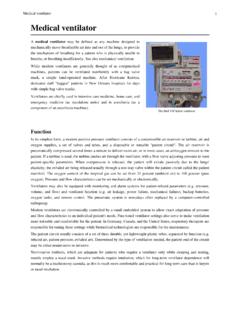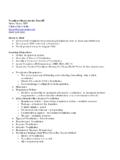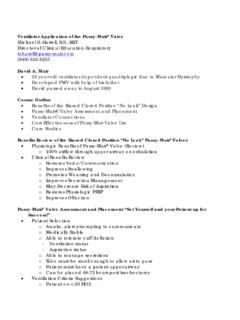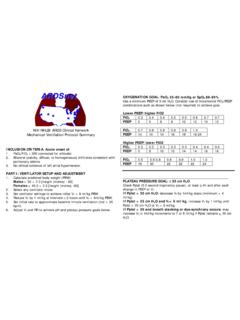Transcription of VENTILATOR WAVEFORM ANALYSIS - A WHO …
1 VENTILATOR WAVEFORM ANALYSISANALYSISByDr M V Nagarjuna1Dr. M. V. NagarjunaSeminar Terminology ( Types of variables, Breaths, modes of ,,ventilation) VENTILATOR waveforms (Scalars)() altered physiological Patient Asynchrony and its (Pressure volume and Flow volume)2 Basics phase variablesBasics phase Trigger ..What causes the breath to begin?BCB. Limit ..What regulates gas flow during the breath? ..What causes the breath to end?VARIABLESVARIABLES1 TRIGGER VARIABLE : Initiates the VARIABLE : Initiates the breath Flow (Assist breath) Pressure (Assist Breath) Pressure (Assist Breath) Time (Control Breath) Newer variables (Volume Shape signal neural)Newer variables (Volume, Shape signal, neural)Flow trigger better than Pressure trigger.
2 Ow t gge ette t a essu e t gge . With the newer ventilators, difference in work of triggering is of minimal clinical significance. gBritish Journal of Anaesthesia, VARIABLE : Controls the gas delivery during the breath Flow ( Volume Control modes) Pressure ( Pressure Control modes) VARIABLE : Cycled from inspiration into iiexpiration Volume ( Volume control)Ti(P l) Time(Pressure control) Flow (pressure Support) P (Sft li ibl) Pressure (Safety cycling variable)5 Modes of VentilationMode of ventilationBreath types availableVolume Assist ControlVolume Control, Volume AssistPressure Assist ControlPressure Control, Pressure Assist,Volume SIMVV olume Control, Volume Assist, Pressure SupportPressure SIMVP ressure Control, Pressure Assist, Pressure SupportPressure SupportPressure support 6 SCALARS7 FLOW vs TIME8 Flow versus timeNever forget to look at the expiratory limb of the flow waveformThe expiratory flow is determined by the elastic recoil of the respiratory system and resistanceof intubated airwaysrespiratory system and resistanceof intubated airways9 Types of Inspiratory flow waveformsaSquare wave wave flowb.
3 Ascending ramp flowcDescending ramp ramp flowd. Sinusoidal floweDecay flow10 Which form to use?? P tl d Al Dlti d fl Pressure control mode : Always Decelerating or decay flow. Cannot be changed. Volume control mode : Flow WAVEFORM can be changed ddi h il idepending on the VENTILATOR FLOW WAVEFORM : Inspiratory time is shortest for Inspiratory time is shortest for Square wave flow form. Highest Peak Inspiratory pressures Low Mean Inspiratory pressure Low Mean Inspiratory pressure,, thus better venous return and cardiac outputDESCENDING RAMP FLOW : Increases inspiratory time (if not fixed) or peak inspiratory flow rate (if inspiratory time is fixed)py Least Peak inspiratory pressures (19% decrease).
4 High mean airway pressure, helps g y p, p lung inflation and and ascending ramp flow :Sinusoidal and ascending ramp flow : Initial flow rates are slow and hence cause dyssynchrony FLOW STARVATIONFLOW STARVATION. Should not be used in assist ramp and Square wave flow : Usually preferred as the initial flow rate meets the flow demand of the patient. Decreases air WAVE FLOWDECSENDING RAMP 14 SQUARE WAVE FLOWFLOWD ecelerating flow WAVEFORM Advantages : Decreases Peak inspiratory pressures Increases oxygenation, decreases A-aDo2 Improves patient VENTILATOR synchrony (more physiological) Disadvantages : Decreases expiratory time , potential for auto PEEP Increases mean airway pressure, decreases cardiac output Increased intracranial pressuresEgan's Fundamentals of Respiratory ed.
5 2003 Ventilation; Physiological and Clinical Applications4thed 2006:113 Mechanical Ventilation; Physiological and Clinical :113. Intensive Care ;11 flow WAVEFORM Passive and determined by compliance of the lung and resistance of the airwaysresistance of the i b b d Four points to be observed Expiratory Flow2Sl f h i li of the expiratory time4D th f h th bli ? the WAVEFORM reach the baseline?16 PRESSURE vs TIME17 Pressure vs Time Scalar18 PIPNo active breathingTt l il itPIPresistanceTreats lung as single unitPplatflowPplatend-inspiratoryalveola r pressureDriving compliancetidal volumePressure (PIP-PEEP)tidal volumePEEPPIP- PEEP= (Flow x Resistance) + (Vt/Compliance RS)tidal volumeRespiratory System ComplianceC =Pplat - PEEP tidal volumePulmonary Disorder: Extra Pulmonary Disorder:Decreased with:y mainstem intubation congestive heart failureARDSE xtra Pulmonary Disorder: abdominal distension chest wall edema/Obesity ARDS Atelectasis, consolidation fibrosis chest wall edema/Obesity thoracic deformity Hyperinflation Tension pneumothoraxll ffNormal.
6 100 mL/cm H2O pleural effusionPlt PEEP = Vt/ CliPplat PEEP = Vt/ Compliance P plateau increased by a)Decreasing compliance of lung : Pulm edema, ARDS, gpgAtelectasis, )Decreasing compliance of the chest wall : Morbid obesity, ascites, stiff chest )Increasing Tidal volumed)Patient VENTILATOR dyssynchrony21 PIPP platInspiratory ResistanceRi= PIP -PplatflowIncreased with: Airways : Secretions, Mucus plugging, Bronchospasmp ET tube : Small size, ET block VENTILATOR Circuit: Kinking Clogged HME VENTILATOR Circuit: Kinking, Clogged HMEN ormal: 5 -10 cm H2O/L/s for intubated ventilated adults2//measured with 60 L/min (1 L/s) constant flowP k P l t = Fl R i tP peak P plat = Flow x Resistance Increased by a)Increasing resistance : Bronchospasm, Mucus gpplugging/secretions, ET block , Biting the ET tube, Tube kinking, Clogged )Increasing flow : Increasing Vt, Increasing , Increasing I.
7 E ratio23 PIPCrs =PltPEEP tidal volumePpl Pplat -PEEPC tidal volumePpl (Peso)Ccw = PesoPalv (Pplat)CL=(Pplat PEEP) - Pesotidal volume(Pplat)(p)Ri=PIP - PplatRiflowSTRESS INDEX (ARDS)Increase PEEP Ideal PEEP Decrease PEEP(Recruitment) (Overdistension)25 SQUARE WAVE FLOWDECSENDING RAMP 26 SQUARE WAVE FLOWFLOWVOLUME vs TIME27 Information derived from VolumeTime ScalarInformation derived from VolumeTime ScalarTidal VolumeVolume on y axisAir leakExpiratory limb fails to return to x axisActive ExpirationTracing continues beyond the baselineA lb fl h h b lAuto PEEPE xpiratory limb fails to reach the baseline28 HOW TO USE THE HOW TO USE THE GRAPHS FOR GRAPHS FOR DIAGNOSIS OF DISEASE DIAGNOSIS OF DISEASE STATES ?
8 STATES ?29 Which waveforms to monitor ?Mode of ventilationIndependent variablesDependent variablesWaveforms that will be usefulWav e f o r m s t h a t normally remain unchangedVo l u m e Control/ Assist-ControlTidal volume, RR, Flow rate, PEEP, I/E ratioPawPressure-time:Changes in Pip, PplatFlow-time (expiratory): Ch i liVo l u m e - t i m eFlow time (inspiratory)Changes in compliancePressure-volume loop: Overdistension, optimal PEEP li d flPressure ControlPaw, Inspiratory time (RR), PEEP and I/E ratioVt, flowVolume-time and flow-time: Changes in Vt and compliancePressure-volume loop: Pressure-timeOverdistension, optimal PEEPP ressure PS and PEEPV tand RR, Volume- timesupport/CPAPVt,and RR, flow, I/E RatioFlow- time(for Vt and VE)30 Increased airway resistance (ACMV- VC) Pressure Time WAVEFORM : Increased difference between Ppeak and Pplat Normal P plat Expiratory flow WAVEFORM :d Decreased PEFR Increased expiratory time Scooped out appearance of expiratory limbScooped out appearance of expiratory limb Potential for auto PEEP Loss of peak (emphysema) Volume Time WAVEFORM .
9 Expiratory limb long31A patient with Endotracheal Tube block (When received from Dialysis room) 32A patient with acute severe asthma on ventilator33 Decreased Compliance of Respiratory System Pressure Time WAVEFORM : Increased P plat and Ppeak Increased P plat and Ppeak. Normal P peak Pplat Flow Time WAVEFORM : Increased PEFR Increased PEFR Shortened expiratory time34 Auto PEEP/Intrinsic PEEPAuto PEEP/Intrinsic PEEPN otice how the expiratory flow failsNotice how the expiratory flow failsto return to the baseline indicatingair trapping (Auto PEEP)Also notice how air trapping causes an increase in airway pressureypdue to increasing end expiratorypressure and end inspiratory lung patient of acute severe asthma.
10 Note failure of expiratory limb to return to baseline3637 AUTO- PEEP : Consequencesq Increases the work of Triggering Ineffective triggering Wo r s e n s O xygenationyg Lung Hyperinflation- barotrauma Hemodynamic CompromiseAUTO PEEP : Recognition ANALYSIS of VENTILATOR graphics: Delay between start of Inspiratory effort and Pressure drop No increase in P peak with increase in Applied PEEP3839 VENTILATOR PATIENT VENTILATOR PATIENT SYNCHRONY SYNCHRONY VSVSDYS-SYNCHRONYSSC O40Wh t i V til t P ti t Sh?What is VENTILATOR Patient Synchrony? The VENTILATOR should start inspiration at pthe time of onset of patients inspiration. Th fl id d b th til t hld The flow provided by the VENTILATOR should meet the flow demand of the The VENTILATOR Inspiratory time should t h ith th ti t ii t timatch with the patients inspiratory Patient Dys-synchronyFLOW CYCLE TRIGGER ASYNCHRONYASYNCHRONYASYNCHRONY1.






